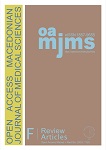The Advantages and Disadvantages of Two Stages Palatoplasty: A Systematic Review
DOI:
https://doi.org/10.3889/oamjms.2023.11037Keywords:
Advantages, Disadvantages, Two stages, PalatoplastyAbstract
BACKGROUND: Two-stage palatoplasty involves soft palate closure–6–8 months after birth, followed by hard palate closure at the age of 12–14 years to avoid early surgical intervention of the hard palate.
AIM: This study aimed to present the advantages and disadvantages of two-stage cleft repair palatoplasty.
METHODS: This study used the literature review method to find articles using the search engine Google Scholar, Ovid, and PubMed. According to the search results, 525 articles were in accordance with the title of the study, but those in accordance with the inclusion criteria amounted to nine articles only.
RESULTS: The results of several studies in this study highlight some of the advantages and disadvantages of the two-stage palatoplasty procedure in several countries.
CONCLUSIONS: Some advantages of two-stage palatoplasty are good maxillary growth and disadvantages, such as increased velopharyngeal insufficiency.
Downloads
Metrics
Plum Analytics Artifact Widget Block
References
Leow AM, Lo LJ. Palatoplasty: Evolution and controversies. Chang Gung Med J. 2008;31(4):335-45. PMid:18935791
Naidu P, Yao CA, Chong DK, Magee WP 3rd. Cleft palate
repair: A history of techniques and variations. Plast Reconstr Surg Glob Open. 2022;10(3):e4019. https://doi.org/10.1097/gox.0000000000004019 PMid:35492233 DOI: https://doi.org/10.1097/GOX.0000000000004019
Agrawal K, Panda KN. Use of vomer flap in palatoplasty: Revisited. Cleft Palate Craniofac J. 2006;43(1):30-7. https://doi.org/10.1597/04-034.1 PMid:16405371 DOI: https://doi.org/10.1597/04-034.1
Schweckendiek W, Doz P. Primary veloplasty: Long-term results without maxillary deformity. A twenty-five year report. Cleft Palate J. 1978;15(3):268-74. PMid:278679
Slaughter WB, Pruzansky S. The rationale for velar closure as a primary procedure in the repair of cleft palate defects. Plast Reconstr Surg (1946). 1954;13(5):341-57. https://doi.org/10.1097/00006534-195405000-00002 PMid:13166609 DOI: https://doi.org/10.1097/00006534-195405000-00002
Madachi K, Takagi R, Asahito T, Kodama Y, Ominato R, Iida A, et al. Cephalometric evaluation after two-stage palatoplasty combined with a Hotz plate: A comparative study between the modified Furlow and Widmaier-Perko methods. Int J Oral Maxillofac Surg. 2017;46(5):539-47. https://doi.org/10.1016/j.ijom.2017.01.009 PMid:28174062 DOI: https://doi.org/10.1016/j.ijom.2017.01.009
Allori AC, Kelley T, Meara JG, Albert A, Bonanthaya K, Chapman K, et al. A standard set of outcome measures for the comprehensive appraisal of cleft care. Cleft Palate Craniofac J. 2017;54(5):540-54. https://doi.org/10.1597/15-292 PMid:27223626 DOI: https://doi.org/10.1597/15-292
Andrade C. Internal, external, and ecological validity in research design, conduct, and evaluation. Indian J Psychol Med. 2018;40(5):498-9. https://doi.org/10.4103/ijpsym.ijpsym_334_18 PMid:30275631 DOI: https://doi.org/10.4103/IJPSYM.IJPSYM_334_18
Neumann S, Romonath R. Application of the international classification of functioning, disability, and health-children and youth version (ICF-CY) to cleft lip and palate. Cleft Palate Craniofac J. 2012;49(3):325-46. https://doi.org/10.1597/10-145 PMid:22292728 DOI: https://doi.org/10.1597/10-145
Semb G, Brattstrom V, Mølsted K, Prahl-Andersen B, Zuurbier P, Rumsey N, et al. The Eurocleft study: Inter-center study of treatment outcome in patients with complete cleft lip and palate. Part 4: Relationship among treatment outcome, patient/parent satisfaction, and the burden of care. Cleft Palate Craniofac J. 2005;42(1):83-92. https://doi.org/10.1597/02-119.4.1 PMid:15643921 DOI: https://doi.org/10.1597/02-119.4.1
Brusati R, Meazzini MC, Rezzonico A, Biglioli F, Garattini G, Battista VM, et al. Evaluation of a sample of patients with unilateral cleft lip and palate treated with a two-stage protocol. J Craniofac Surg. 2018;29(8):2058-64. https://doi.org/10.1097/scs.0000000000004789 PMid:30277945 DOI: https://doi.org/10.1097/SCS.0000000000004789
Potemra HM, Lin J, Bertrand AA, De Leon FS, Alford JA, Hu AC, et al. Long-term effect of multiple operations on psychosocial function in teenage cleft lip and palate patients. Plast Reconstr Surg. 2020;146(1):61e-8. https://doi.org/10.1097/prs.0000000000006905 PMid:32590656 DOI: https://doi.org/10.1097/PRS.0000000000006905
Ozawa TO, Reis LL, Kato RM, Rocha DL, Sathler R, Garib DG. Facial and nasolabial aesthetics of complete UCLP submitted to 2-stage palate repair with vomer flap. Cleft Palate Craniofac J. 2018;55(9):1211-7. https://doi.org/10.1177/1055665618767418 PMid:29652533 DOI: https://doi.org/10.1177/1055665618767418
Eriguchi M, Watanabe A, Suga K, Nakano Y, Sakamoto T, Sueishi K, et al. Growth of palate in unilateral cleft lip and palate patients undergoing two-stage palatoplasty and orthodontic treatment. Bull Tokyo Dent Coll. 2018;59(3):183-91. https://doi.org/10.2209/tdcpublication.2017-0014 PMid:30224612 DOI: https://doi.org/10.2209/tdcpublication.2017-0014
Mizuno S, Kurita K, Imaoka K, Hanai H, Matsui Y, Katayama Y, et al. Two-stage cleft palate closure by our treatment algorithm in complete unilateral cleft lip and palate: Results of maxillary growth at 6 years of age. J Oral Maxillofac Surg Med Pathol. 2019;31(2):59-64. https://doi.org/10.1016/j.ajoms.2018.12.003 DOI: https://doi.org/10.1016/j.ajoms.2018.12.003
Chung KH, Lo LJ. One-stage versus two-stage repair of asymmetric bilateral cleft lip: A 20-year retrospective study of clinical outcome. Plast Reconstr Surg. 2018;141(5):1215-24. https://doi.org/10.1097/prs.0000000000004327 PMid:29351180 DOI: https://doi.org/10.1097/PRS.0000000000004327
Feitosa LB. Aesthetic Outcome of the Face after 2-stage Palate Repair for Complete Unilateral Cleft Lip and Palate. Doctoral Dissertation, Universidade de São Paulo; 2022.
Reddy RR, Reddy SG, Chilakalapudi A, Kokali S, Bronkhorst EM, Kummer AW, et al. Effect of one-stage versus two-stage palatoplasty on hypernasality and fistula formation in children with complete unilateral cleft lip and palate: A randomized controlled trial. Plast Reconstr Surg. 2018;142(1):42e-50e. https://doi.org/10.1097/prs.0000000000004486 PMid:29652768 DOI: https://doi.org/10.1097/PRS.0000000000004486
Elkasry MT, Ghanem WA, Radwan AB, Gadallah MA, Mostafa MS, Albaghdady AA. One-stage simultaneous cleft lip and palate repair versus two-stage repair in children with complete unilateral cleft lip and palate: A randomized controlled study. Egypt J Surg. 2021;40(4):1455-61. https://doi.org/10.4103/ejs.ejs_263_21
McCrary H, Pollard SH, Torrecillas V, Khong L, Taylor HM, Meier J, et al. Increased risk of velopharyngeal insufficiency in patients undergoing staged palate repair. Cleft Palate Craniofac J. 2020;57(8):975-83. https://doi.org/10.1177/1055665620913440 PMid:32207321 DOI: https://doi.org/10.1177/1055665620913440
Sabbag A, Denadai R, Raposo-Amaral CA, Buzzo CL, Raposo- Amaral CE, Nagae MH. Electromyographic activity of the masseter and temporal muscles in patients with nonsyndromic complete unilateral cleft lip and palate: 2-stage versus 1-stage palate repair. J Craniofac Surg. 2018;29(6):1463-8. https://doi.org/10.1097/SCS.0000000000004587 PMid:29762320 DOI: https://doi.org/10.1097/SCS.0000000000004587
Downloads
Published
How to Cite
Issue
Section
Categories
License
Copyright (c) 2023 Arya Tjipta, Hafiz Ramadhan, Rahmi Lubis (Author)

This work is licensed under a Creative Commons Attribution-NonCommercial 4.0 International License.
http://creativecommons.org/licenses/by-nc/4.0







